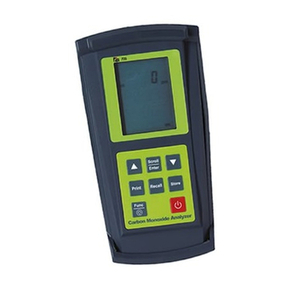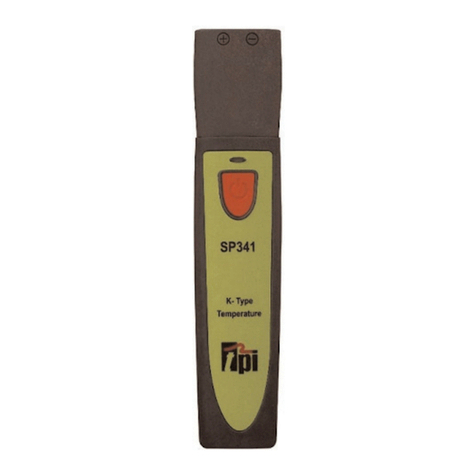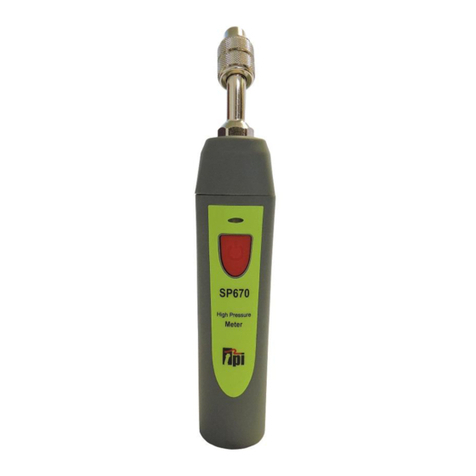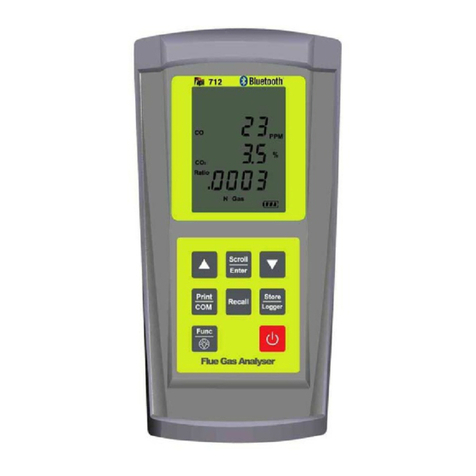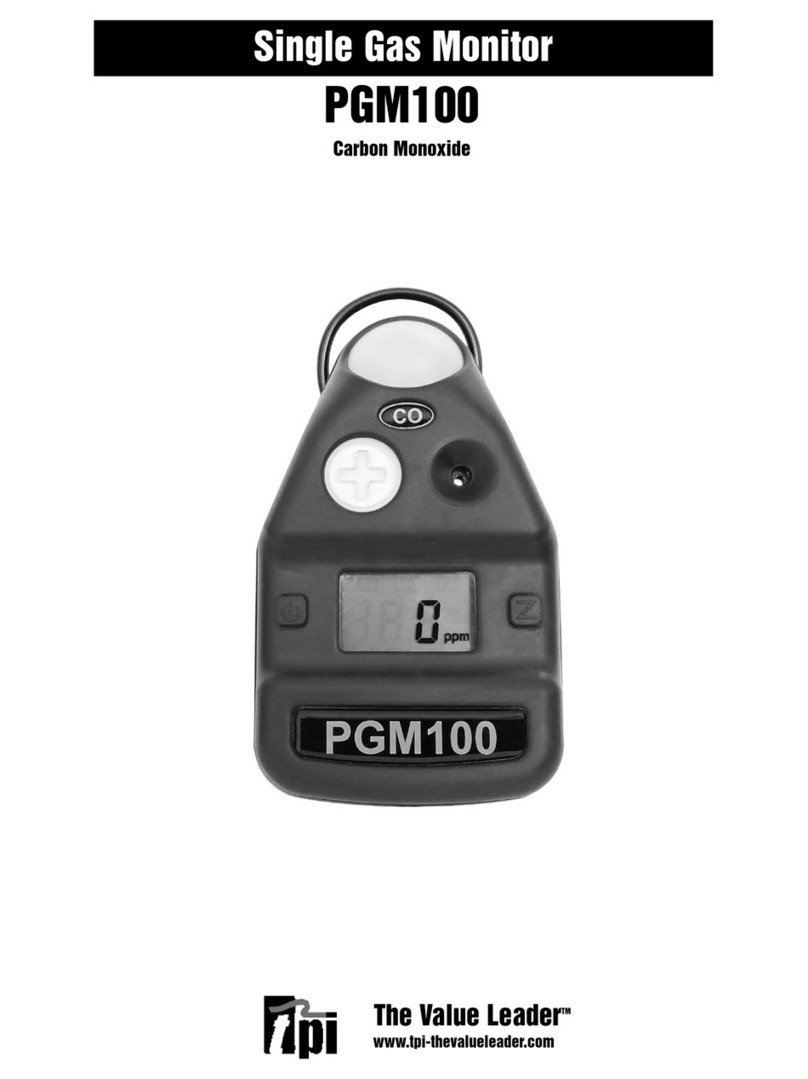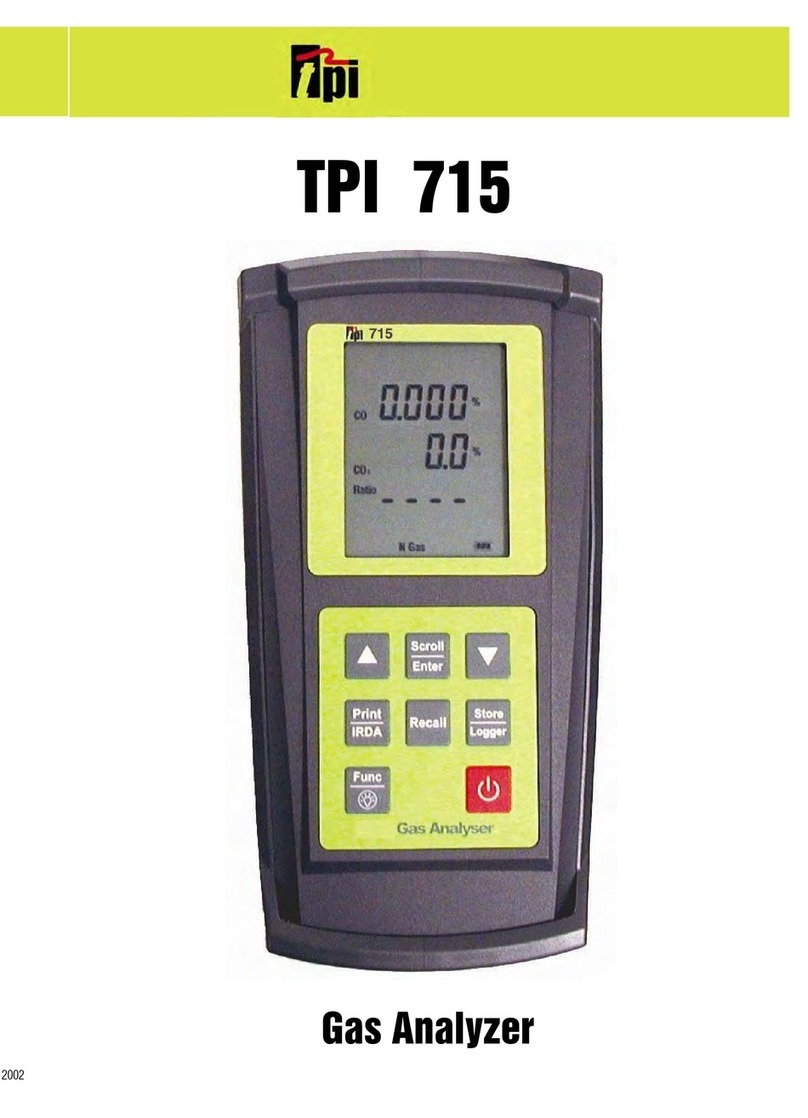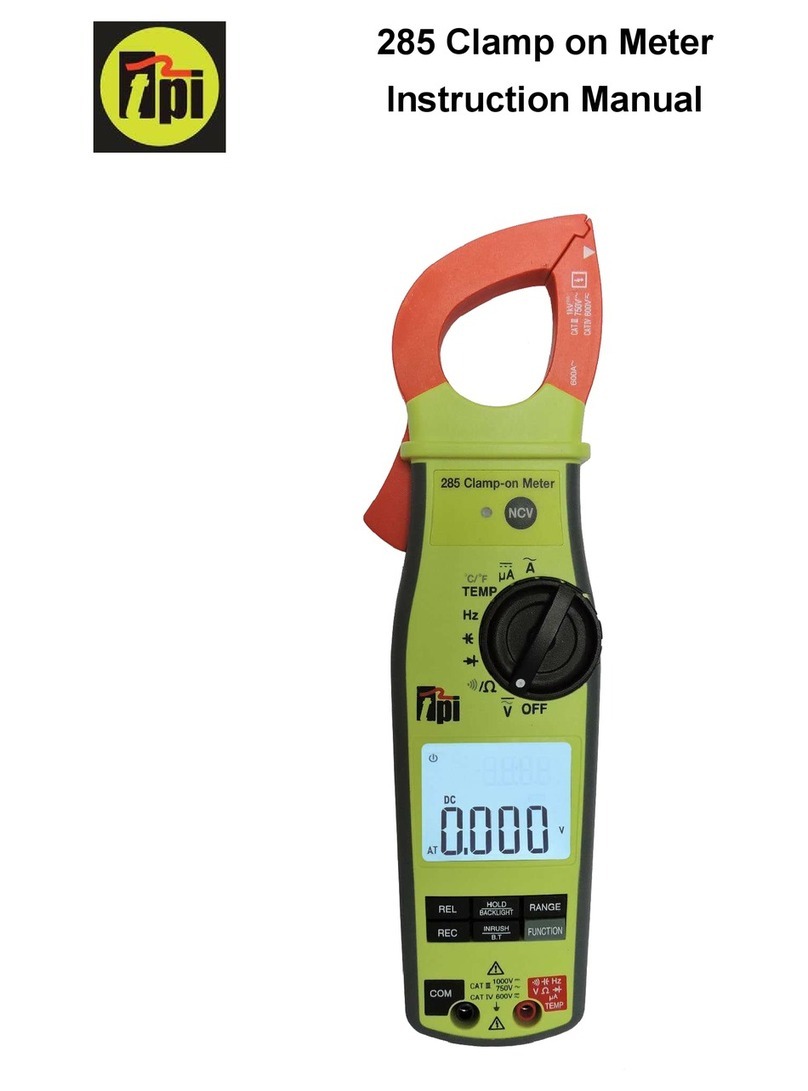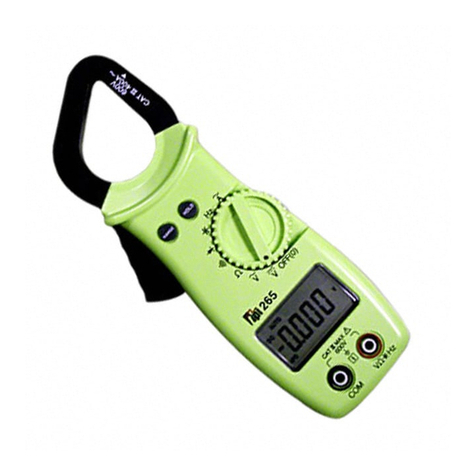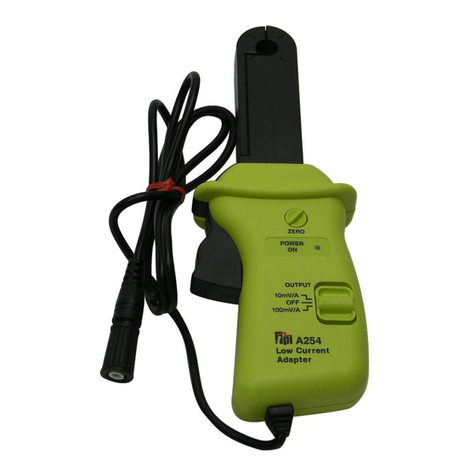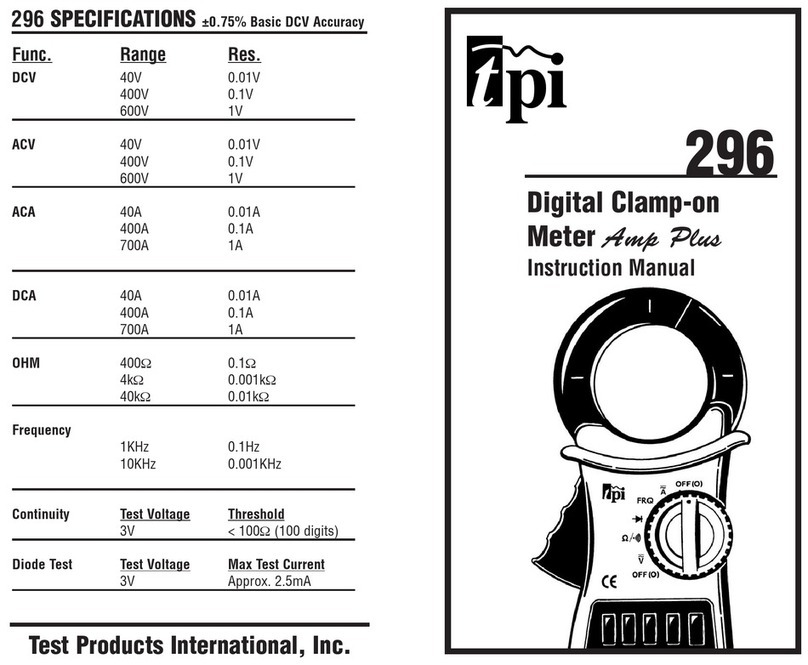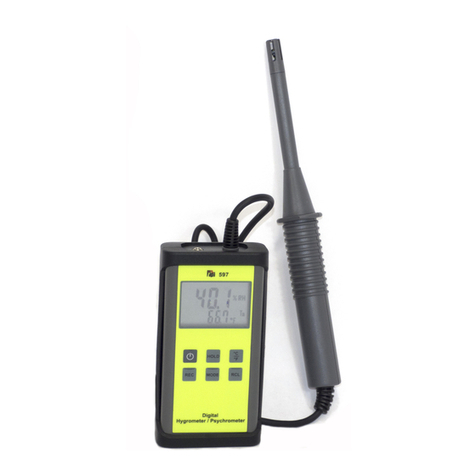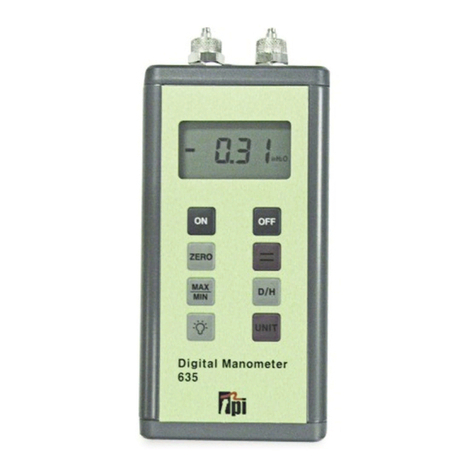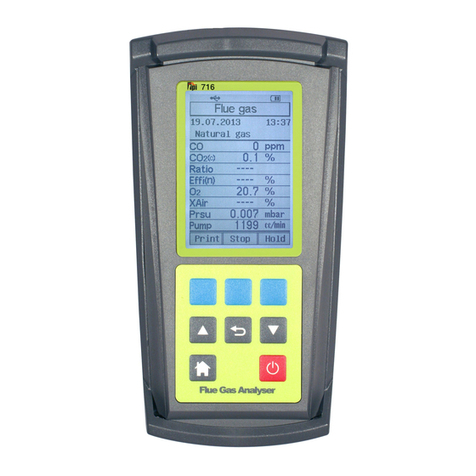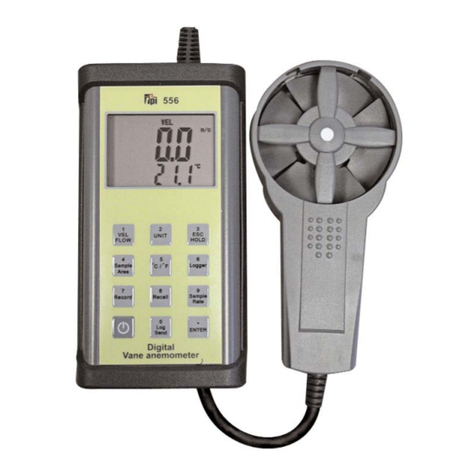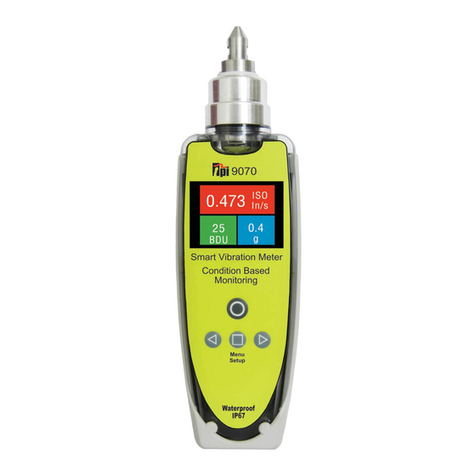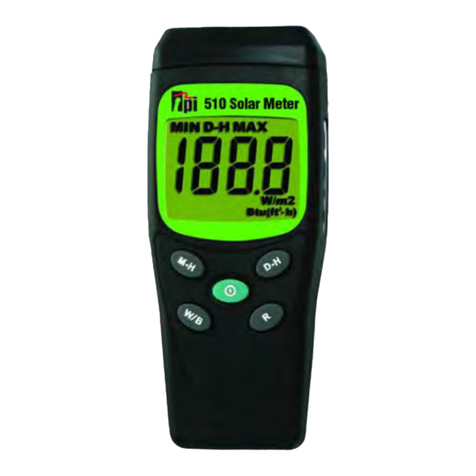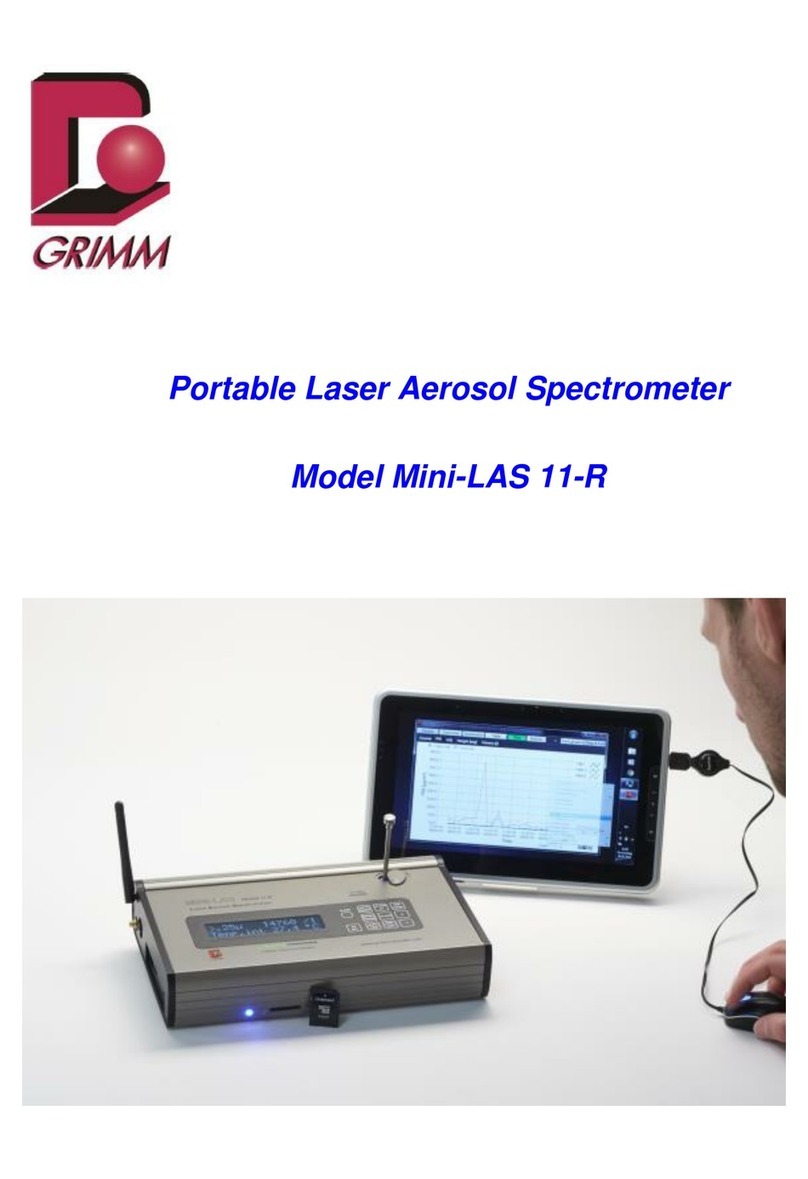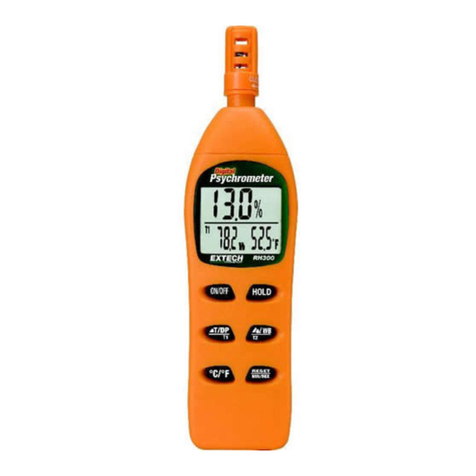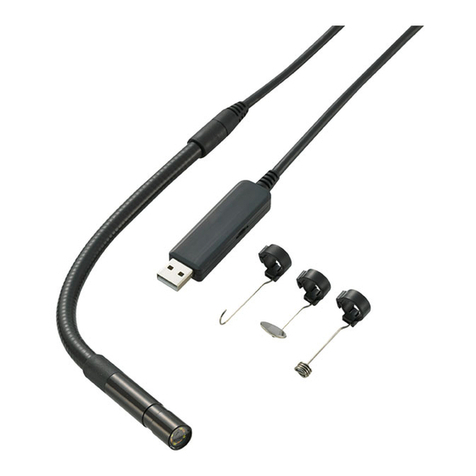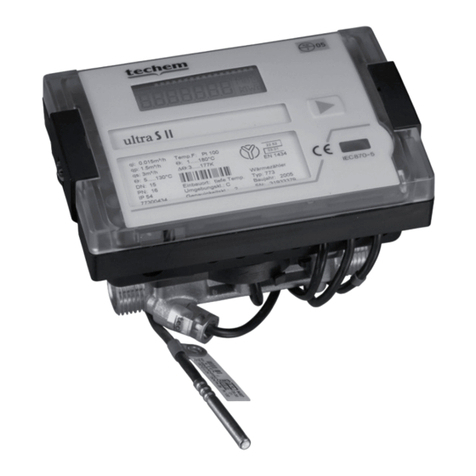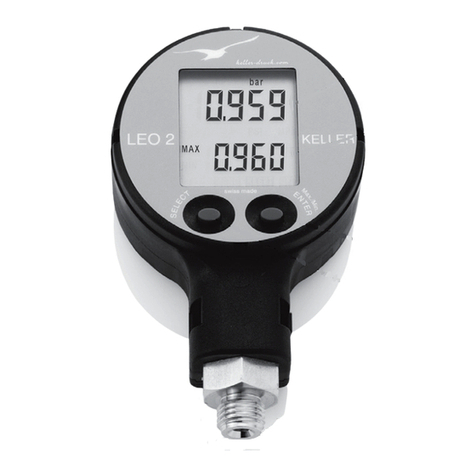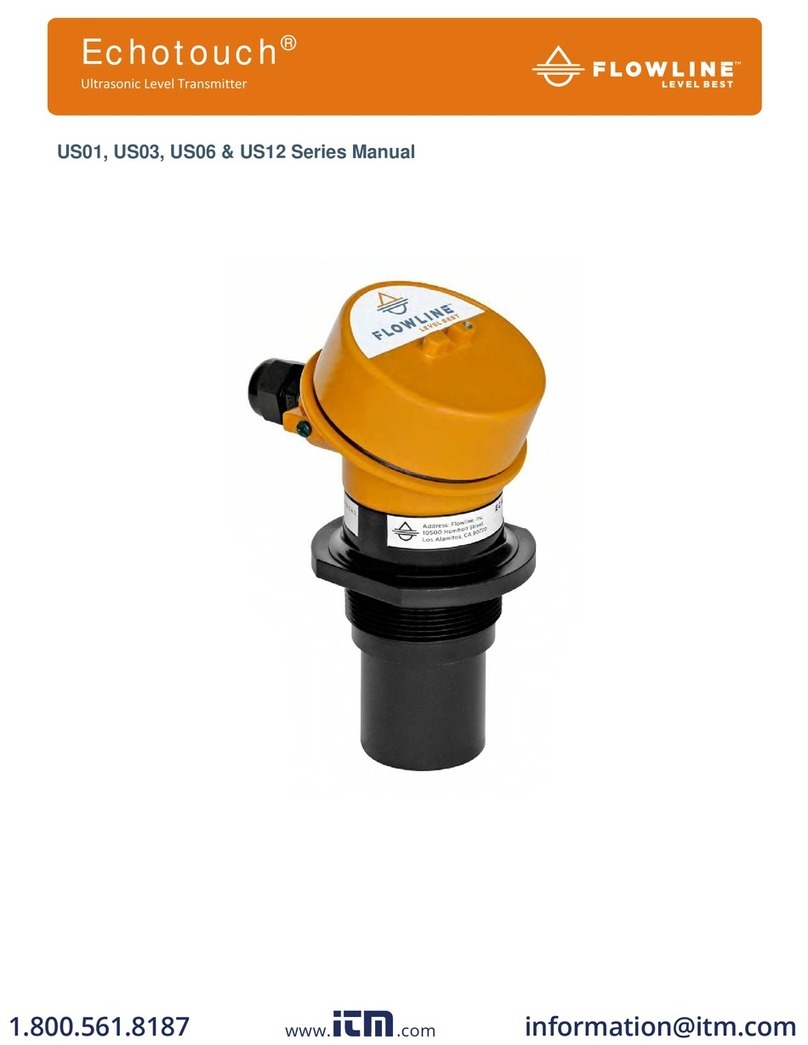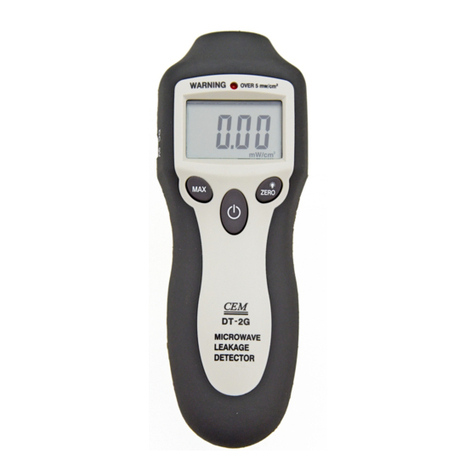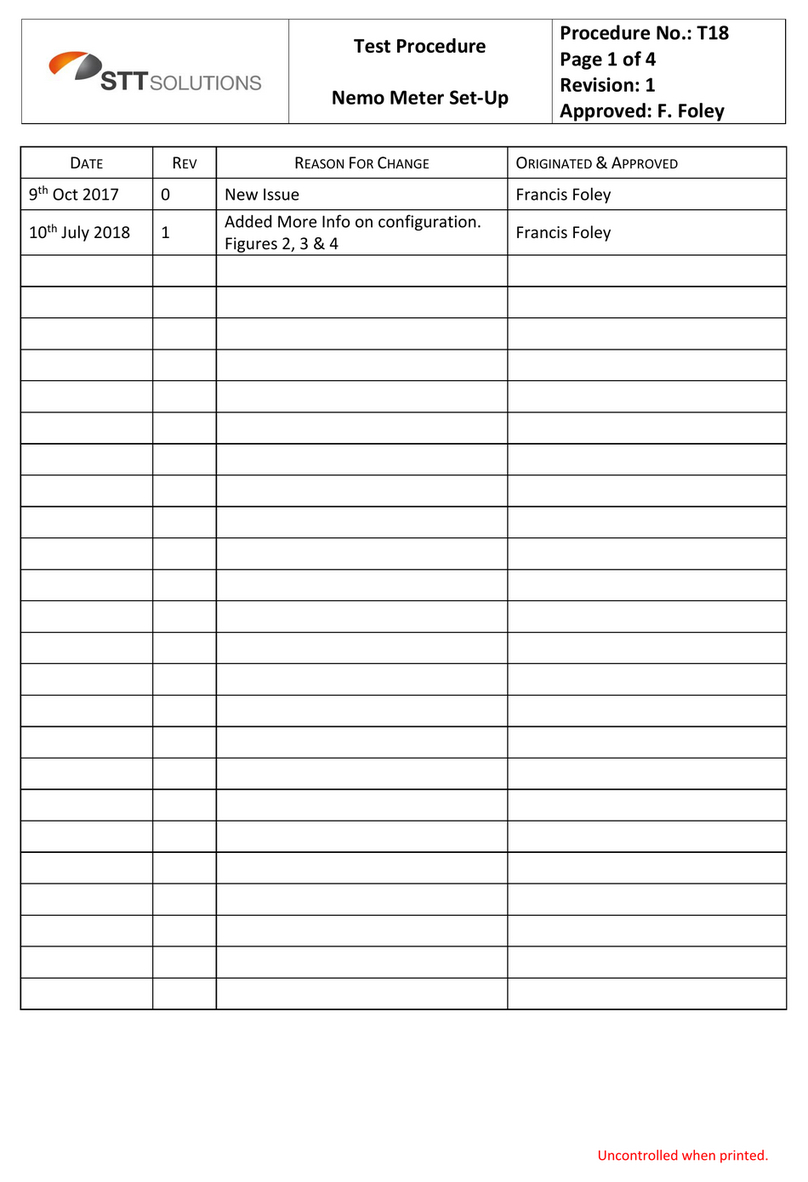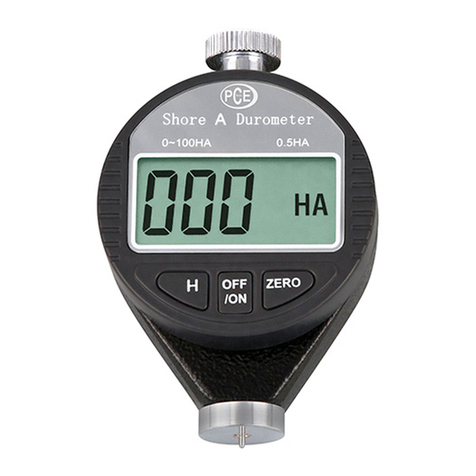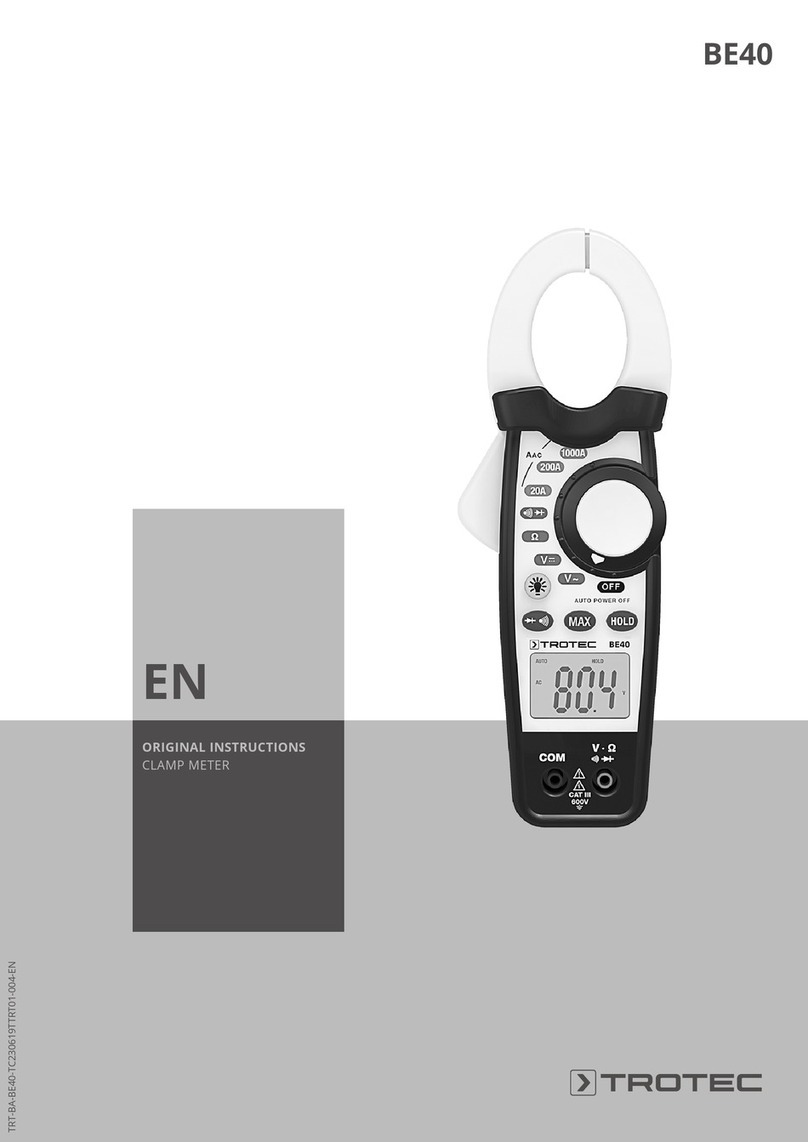TPI Amp Plus 296 User manual

296
Digital Clamp-on
Meter Amp Plus
Instruction Manual
www. .com information@itm.com1.800.561.8187
All manuals and user guides at all-guides.com
all-guides.com

3
2
A. INTRODUCTION
1. Congratulations!!
Thank you for purchasing TPI products. The
Amp Plus is easy to use and is built to last.
It is backed by a 3 year limited warranty.
Please remember to complete and return
your product warranty registration card.
2. Product Description
The 296 is a clamp-on plus DMM with True RMS and
Harmonics capabilities. The 296 offers measurements in
all basic electrical functions, plus:
•True RMS Provides accurate and dependable
readings of non-linear loads.
•HDR Mode Determines if a signal is clean or
distorted.
•Bar Graph When measuring frequency, bar
graph indicates current level.
•TRIM Mode Smooths out unstable readings.
•Peak Mode For start-up and inrush currents.
•Sleep Mode Preserves battery life.
•Data Hold Holds the reading on the display for
easy viewing.
The 296 comes complete with the following accessories:
Carrying Pouch Instruction Manual
Test Lead Set Battery
TABLE OF CONTENTS
A. INTRODUCTION
1. Congratulations ..........................3
2. Product Description....................3
3. Declaration of Conformity ..........4
B. SAFETY CONSIDERATIONS ..............5
C. TECHNICAL DATA
1. Features and Benefits..................7
2. Product Applications ..................8
3. Specifications..............................9
D. MEASUREMENT TECHNIQUES
1. Controls and Functions ............12
2. Step by Step Procedures: ........15
E. ACCESSORIES ................................28
F. MAINTENANCE ................................29
G. TROUBLE SHOOTING GUIDE ..........30
www. .com information@itm.com1.800.561.8187
All manuals and user guides at all-guides.com

3
2
A. INTRODUCTION
1. Congratulations!!
Thank you for purchasing TPI products. The
Amp Plus is easy to use and is built to last.
It is backed by a 3 year limited warranty.
Please remember to complete and return
your product warranty registration card.
2. Product Description
The 296 is a clamp-on plus DMM with True RMS and
Harmonics capabilities. The 296 offers measurements in
all basic electrical functions, plus:
•True RMS Provides accurate and dependable
readings of non-linear loads.
•HDR Mode Determines if a signal is clean or
distorted.
•Bar Graph When measuring frequency, bar
graph indicates current level.
•TRIM Mode Smooths out unstable readings.
•Peak Mode For start-up and inrush currents.
•Sleep Mode Preserves battery life.
•Data Hold Holds the reading on the display for
easy viewing.
The 296 comes complete with the following accessories:
Carrying Pouch Instruction Manual
Test Lead Set Battery
TABLE OF CONTENTS
A. INTRODUCTION
1. Congratulations ..........................3
2. Product Description....................3
3. Declaration of Conformity ..........4
B. SAFETY CONSIDERATIONS ..............5
C. TECHNICAL DATA
1. Features and Benefits..................7
2. Product Applications ..................8
3. Specifications..............................9
D. MEASUREMENT TECHNIQUES
1. Controls and Functions ............12
2. Step by Step Procedures: ........15
E. ACCESSORIES ................................28
F. MAINTENANCE ................................29
G. TROUBLE SHOOTING GUIDE ..........30
www. .com information@itm.com1.800.561.8187
All manuals and user guides at all-guides.com

5
4
B. SAFETY CONSIDERATIONS
WARNING: Please follow manufacturers test
procedures whenever possible. Do not attempt to
measure unknown voltages or components until a
complete understanding of the circuit is obtained.
GENERAL GUIDELINES
ALWAYS
• Test the 296 before using it to make sure it is
operating properly.
• Inspect the test leads before using to make sure there
are no breaks or shorts.
• Double check all connections before testing.
• Have someone check on you periodically if
working alone.
• Have a complete understanding of the circuit
being measured.
• Disconnect power to circuit, then connect test leads to
the 296, then to circuit being measured.
NEVER
• Attempt to measure unknown high voltages.
• Attempt to measure current with the meter in
parallel to the circuit.
• Connect the test leads to a live circuit before
setting up the instrument.
• Touch any exposed metal part of the test lead assembly.
3. EC Declaration of Conformity
This is to certify that TPI Model 296 conforms to the
protection requirements of the council directive
89/336/EEC, in the approximation of laws of the member
states relating to Electromagnetic compatibility and
73/23/EEC. The Low Voltage Directive by application of
the following standards:
EN 50081-1 1992 Emissions Standard
EN 50082-1 1992 Immunity Standard
EN 61010-1 1993 Safety Standard
EN 61010-2-031 1995 Safety Standard
EN 61010-2-032 1995 Safety Standard
To ensure conformity with these standard, this instru-
ment must be operated in accordance with the instruc-
tions and specifications given in this manual.
CAUTION: Even though this instrument complies with
the immunity standards, it’s accuracy can be affected
by strong radio emissions not covered in the above
standards. Sources such as hand-held radio trans-
ceivers, radio and TV transmitters, vehicle radios and
cellular phones generate electromagnetic radiation
that could be induced into the test leads of this instru-
ment. Care should be taken to avoid such situations or
alternatively, check to make sure that the instrument is
not being influence by these emissions.
CAUTION: Please follow manufacturers test proce-
dures whenever possible. Do not attempt to measure
unknown voltages or components until a complete
understanding of the circuit is obtained.
!
www. .com information@itm.com1.800.561.8187
All manuals and user guides at all-guides.com

5
4
B. SAFETY CONSIDERATIONS
WARNING: Please follow manufacturers test
procedures whenever possible. Do not attempt to
measure unknown voltages or components until a
complete understanding of the circuit is obtained.
GENERAL GUIDELINES
ALWAYS
• Test the 296 before using it to make sure it is
operating properly.
• Inspect the test leads before using to make sure there
are no breaks or shorts.
• Double check all connections before testing.
• Have someone check on you periodically if
working alone.
• Have a complete understanding of the circuit
being measured.
• Disconnect power to circuit, then connect test leads to
the 296, then to circuit being measured.
NEVER
• Attempt to measure unknown high voltages.
• Attempt to measure current with the meter in
parallel to the circuit.
• Connect the test leads to a live circuit before
setting up the instrument.
• Touch any exposed metal part of the test lead assembly.
3. EC Declaration of Conformity
This is to certify that TPI Model 296 conforms to the
protection requirements of the council directive
89/336/EEC, in the approximation of laws of the member
states relating to Electromagnetic compatibility and
73/23/EEC. The Low Voltage Directive by application of
the following standards:
EN 50081-1 1992 Emissions Standard
EN 50082-1 1992 Immunity Standard
EN 61010-1 1993 Safety Standard
EN 61010-2-031 1995 Safety Standard
EN 61010-2-032 1995 Safety Standard
To ensure conformity with these standard, this instru-
ment must be operated in accordance with the instruc-
tions and specifications given in this manual.
CAUTION: Even though this instrument complies with
the immunity standards, it’s accuracy can be affected
by strong radio emissions not covered in the above
standards. Sources such as hand-held radio trans-
ceivers, radio and TV transmitters, vehicle radios and
cellular phones generate electromagnetic radiation
that could be induced into the test leads of this instru-
ment. Care should be taken to avoid such situations or
alternatively, check to make sure that the instrument is
not being influence by these emissions.
CAUTION: Please follow manufacturers test proce-
dures whenever possible. Do not attempt to measure
unknown voltages or components until a complete
understanding of the circuit is obtained.
!
www. .com information@itm.com1.800.561.8187
All manuals and user guides at all-guides.com

67
INTERNATIONAL SYMBOLS
CAUTION: RISK OF ELECTRIC SHOCK
AC (ALTERNATION CURRENT)
DC (DIRECT CURRENT)
REFER TO INSTRUCTION MANUAL
GROUND
DOUBLE INSULATION
EITHER DC OR AC
!
C. TECHNICAL DATA
1. Features and Benefits
Agency UL Listed to U.S. and Canadian Safety
Standards. Meets CE and IEC 1010.
True RMS Needed to accurately measure non-sinu-
soidal AC voltage and current waveforms
found on many controls and circuits.
HDR Mode Determines if a signal is clean or distorted.
Displays the harmonic distortion ratio on
ACV and ACA at line voltage and 60 Hz.
4000 Count Improves the resolution on all functions
and ranges.
Data Hold Maintains the reading on the display for
hard to reads areas.
Peak Mode Measure the inrush current of motors,
relays and solenoids.
Trim Mode Averages the readings for more stable out-
put on LCD.
Record Mode Records Min/Max and Average value of the
function being measured.
Sleep Mode Automatically powers down after 10
minutes of inactivity.
Frequency Measures the frequency of the current
being measured.
Dual Display When measuring frequency, the bar graph
indicates the current level.
Bar Graph Shows rapidly changing input signals
that the normal display will not.
www. .com information@itm.com1.800.561.8187
All manuals and user guides at all-guides.com
all-guides.com

67
INTERNATIONAL SYMBOLS
CAUTION: RISK OF ELECTRIC SHOCK
AC (ALTERNATION CURRENT)
DC (DIRECT CURRENT)
REFER TO INSTRUCTION MANUAL
GROUND
DOUBLE INSULATION
EITHER DC OR AC
!
C. TECHNICAL DATA
1. Features and Benefits
Agency UL Listed to U.S. and Canadian Safety
Standards. Meets CE and IEC 1010.
True RMS Needed to accurately measure non-sinu-
soidal AC voltage and current waveforms
found on many controls and circuits.
HDR Mode Determines if a signal is clean or distorted.
Displays the harmonic distortion ratio on
ACV and ACA at line voltage and 60 Hz.
4000 Count Improves the resolution on all functions
and ranges.
Data Hold Maintains the reading on the display for
hard to reads areas.
Peak Mode Measure the inrush current of motors,
relays and solenoids.
Trim Mode Averages the readings for more stable out-
put on LCD.
Record Mode Records Min/Max and Average value of the
function being measured.
Sleep Mode Automatically powers down after 10
minutes of inactivity.
Frequency Measures the frequency of the current
being measured.
Dual Display When measuring frequency, the bar graph
indicates the current level.
Bar Graph Shows rapidly changing input signals
that the normal display will not.
www. .com information@itm.com1.800.561.8187
All manuals and user guides at all-guides.com

9
3. Specifications
IEC 1010 Over Voltage:
CAT II - 1000V
CAT III - 600V
Pollution Degree 2
a. DCV
Range Resolution Accuracy Impedance
40V 0.01V ±0.75% of reading, 10Mohm
400V 0.1V ±3 digits
600V 1V
b1. ACV (45Hz to 60Hz)
Range Resolution Accuracy Impedance
40V 0.01V ±1.0% of reading, 10Mohm
400V 0.1V ±3 digits
600V 1V
b2. ACV (20Hz to 45Hz, 60Hz to 1KHz)
Range Resolution Accuracy Impedance
40V 0.01V ±2.5% of reading, 10Mohm
400V 0.1V ±3 digits
600V 1V
UL 3111-1
8
2. Product Applications
Perform the following tests and/or measurements with
the 296 and the appropriate function:
HVAC/R
ACA • Heat anticipator current in thermostats.
ACV • Line voltage.
ACV or DCV • Control circuit voltage.
OHMS • Heating element resistance (continuity).
OHMS • Compressor winding resistance.
OHMS • Contactor and relay coil resistance.
ACA • Motor and compressor start up current.
OHMS • Continuity of wiring.
Hz/FREQ • Frequency on control and line voltages.
REC • Record min/max voltage of controls
and line voltages.
ALL • Bar graph to indicate rapid fluctuations.
ELECTRICAL
ACV • Measure line voltage.
ACA • Measure line current.
OHMS • Continuity of circuit breakers.
DCV • Voltage of direct drive DC motors.
DCA • Current of direct drive DC motors.
ACA • Start up current of motors, relays,
contactors and transformers.
ALL • Harmonics detection on line voltages.
ELECTRONIC
ACV • Measure power supply voltage.
ACA • Measure power supply current.
OHMS • Continuity of circuit breakers and fuses.
www. .com information@itm.com1.800.561.8187
All manuals and user guides at all-guides.com

9
3. Specifications
IEC 1010 Over Voltage:
CAT II - 1000V
CAT III - 600V
Pollution Degree 2
a. DCV
Range Resolution Accuracy Impedance
40V 0.01V ±0.75% of reading, 10Mohm
400V 0.1V ±3 digits
600V 1V
b1. ACV (45Hz to 60Hz)
Range Resolution Accuracy Impedance
40V 0.01V ±1.0% of reading, 10Mohm
400V 0.1V ±3 digits
600V 1V
b2. ACV (20Hz to 45Hz, 60Hz to 1KHz)
Range Resolution Accuracy Impedance
40V 0.01V ±2.5% of reading, 10Mohm
400V 0.1V ±3 digits
600V 1V
UL 3111-1
8
2. Product Applications
Perform the following tests and/or measurements with
the 296 and the appropriate function:
HVAC/R
ACA • Heat anticipator current in thermostats.
ACV • Line voltage.
ACV or DCV • Control circuit voltage.
OHMS • Heating element resistance (continuity).
OHMS • Compressor winding resistance.
OHMS • Contactor and relay coil resistance.
ACA • Motor and compressor start up current.
OHMS • Continuity of wiring.
Hz/FREQ • Frequency on control and line voltages.
REC • Record min/max voltage of controls
and line voltages.
ALL • Bar graph to indicate rapid fluctuations.
ELECTRICAL
ACV • Measure line voltage.
ACA • Measure line current.
OHMS • Continuity of circuit breakers.
DCV • Voltage of direct drive DC motors.
DCA • Current of direct drive DC motors.
ACA • Start up current of motors, relays,
contactors and transformers.
ALL • Harmonics detection on line voltages.
ELECTRONIC
ACV • Measure power supply voltage.
ACA • Measure power supply current.
OHMS • Continuity of circuit breakers and fuses.
www. .com information@itm.com1.800.561.8187
All manuals and user guides at all-guides.com

11
10
g. Diode Test
Test Voltage Max Test Current Over Load Protection
3V Approx. 2.5mA 600 V DC or Peak AC
h. Frequency
Range Res. Accuracy Overload
Protection
1KHz 0.1Hz ±0.2% of reading, 600V DC or
10KHz 0.001KHz ±3 digits AC Peak
h. General Specifications
Max. Volt. between 600V
any Input and Ground
Display Type 4,000 Count, 4 times per
second update
Operating Temp. -10° to 45°C (14° to 113°F)
Storage Temp. -20° to 55°C (-4° to 131°F)
Relative Humidity 0% to 80% (0° - 35°C/32° - 95°F)
0% to 70% (35° - 50°C/95° - 122°F)
Power Supply 9 Volt Battery
Battery Life 80 hrs. Alkaline
Size (H x L x W) 40mm x 190mm x 65mm
(1.5in x 7.25in x 2.5in)
Weight 315g (11.1oz)
c. ACA
Range Res. Accuracy Freq. Response
40A 0.01A ±2% of reading, ±20 digits 45Hz to 60Hz
±4% of reading, ±20 digits 30Hz to 45Hz
±4% of reading, ±20 digits 60Hz to 1KHz
400A 0.1A ±2% of reading, ±10 digits 45Hz to 60Hz
700A 1A ±5% of reading, ±10 digits 30Hz to 45Hz
±5% of reading, ±10 digits 60Hz to 1KHz
d. DCA
Range Resolution Accuracy
400A 0.1A ±2% of reading, ±10 digits
700A 1A ±2% of reading, ±15 digits
e. OHM (Resistance, )
Range Res. Accuracy Overload
Protection
400 0.1 ±1% of reading, ±10 digits 600V DC or
4k 0.001k ±1% of reading, ±3 digits AC Peak
40k 0.01k
f. Continuity Buzzer
Test Voltage Threshold Over Load Protection
3V < 100 ohm(100 digits) 600 V DC or Peak AC
*Warning: Test Leads. Use only correct type and
overvoltage category rating.
!
www. .com information@itm.com1.800.561.8187
All manuals and user guides at all-guides.com

11
10
g. Diode Test
Test Voltage Max Test Current Over Load Protection
3V Approx. 2.5mA 600 V DC or Peak AC
h. Frequency
Range Res. Accuracy Overload
Protection
1KHz 0.1Hz ±0.2% of reading, 600V DC or
10KHz 0.001KHz ±3 digits AC Peak
h. General Specifications
Max. Volt. between 600V
any Input and Ground
Display Type 4,000 Count, 4 times per
second update
Operating Temp. -10° to 45°C (14° to 113°F)
Storage Temp. -20° to 55°C (-4° to 131°F)
Relative Humidity 0% to 80% (0° - 35°C/32° - 95°F)
0% to 70% (35° - 50°C/95° - 122°F)
Power Supply 9 Volt Battery
Battery Life 80 hrs. Alkaline
Size (H x L x W) 40mm x 190mm x 65mm
(1.5in x 7.25in x 2.5in)
Weight 315g (11.1oz)
c. ACA
Range Res. Accuracy Freq. Response
40A 0.01A ±2% of reading, ±20 digits 45Hz to 60Hz
±4% of reading, ±20 digits 30Hz to 45Hz
±4% of reading, ±20 digits 60Hz to 1KHz
400A 0.1A ±2% of reading, ±10 digits 45Hz to 60Hz
700A 1A ±5% of reading, ±10 digits 30Hz to 45Hz
±5% of reading, ±10 digits 60Hz to 1KHz
d. DCA
Range Resolution Accuracy
400A 0.1A ±2% of reading, ±10 digits
700A 1A ±2% of reading, ±15 digits
e. OHM (Resistance, )
Range Res. Accuracy Overload
Protection
400 0.1 ±1% of reading, ±10 digits 600V DC or
4k 0.001k ±1% of reading, ±3 digits AC Peak
40k 0.01k
f. Continuity Buzzer
Test Voltage Threshold Over Load Protection
3V < 100 ohm(100 digits) 600 V DC or Peak AC
*Warning: Test Leads. Use only correct type and
overvoltage category rating.
!
www. .com information@itm.com1.800.561.8187
All manuals and user guides at all-guides.com
all-guides.com

13
12
1. Controls and Functions (cont.):
Rotary Switch
OFF Turns the 296 completely off.
VUsed to measure AC and DC volts.
ΩUsed to measure resistance and
use the continuity buzzer.
Used to measure diodes.
FRQ Used to measure the frequency of
the current through the jaws.
AUsed to measure AC amps.
OFF Turns the 296 completely off.
Input Jacks
COM Black test lead connection for
ACV, DCV, , Continuity Buzzer and
Diode Test functions.
V/ΩRed test lead connection for all
ACV, DCV, , Continuity Buzzer and
Diode Test functions.
D. MEASUREMENT TECHNIQUES
1. Controls and Functions:
Push Buttons
TRIM Activates TRIM, PEAK and HDR
functions (Except on Frequency
Range).
FUNC Toggles between AC and DC volts,
amps and or functions.
RNG Activates manual ranging. Hold in
for 2 seconds to return to
autorange.
HOLD Holds the reading on the display
until the button is pushed a
second time.
REC Activates the Min/Max/Record
mode. (Except on Frequency
Range).
www. .com information@itm.com1.800.561.8187
All manuals and user guides at all-guides.com

13
12
1. Controls and Functions (cont.):
Rotary Switch
OFF Turns the 296 completely off.
VUsed to measure AC and DC volts.
ΩUsed to measure resistance and
use the continuity buzzer.
Used to measure diodes.
FRQ Used to measure the frequency of
the current through the jaws.
AUsed to measure AC amps.
OFF Turns the 296 completely off.
Input Jacks
COM Black test lead connection for
ACV, DCV, , Continuity Buzzer and
Diode Test functions.
V/ΩRed test lead connection for all
ACV, DCV, , Continuity Buzzer and
Diode Test functions.
D. MEASUREMENT TECHNIQUES
1. Controls and Functions:
Push Buttons
TRIM Activates TRIM, PEAK and HDR
functions (Except on Frequency
Range).
FUNC Toggles between AC and DC volts,
amps and or functions.
RNG Activates manual ranging. Hold in
for 2 seconds to return to
autorange.
HOLD Holds the reading on the display
until the button is pushed a
second time.
REC Activates the Min/Max/Record
mode. (Except on Frequency
Range).
www. .com information@itm.com1.800.561.8187
All manuals and user guides at all-guides.com

15
14
2. Step by Step Procedures:
a. Measuring DC Volts
WARNING!
Do not attempt to make a voltage measurement of
more than 600V or of a voltage level that is unknown.
Instrument set-up:
FUNC. BLACK RED MIN MAXI
TEST LEAD TEST LEAD READING READING
V COM V/Ω0.01V 600V
Measurement Procedure:
1. Disconnect power to circuit to be measured.
2. Plug black test lead into the COM input jack.
3 Plug red test lead into the V/Ωinput jack.
4. Set rotary switch to the V range.
5. Push FUNC button so AC does not show on LCD.
6. Connect test leads to circuit to be measured.
7. Reconnect power to circuit to be measured.
8. Read the voltage on the 296.
Optional Modes
•TRIM: Push TRIM button to stabilize
reading.
•HOLD: Freezes the reading on the LCD.
•RANGE: Manually ranges the instrument.
•REC: Record minimum, maximum and
average values.
Application Notes
When measuring DC Voltage of a bat-
tery, the most accurate reading can be
attained by testing the battery under
load. To accomplish this, follow steps
1 through 4 shown on page 15 and
the following (with the battery in
holder and device turned on):
• Connect the red test lead from the
meter to the positive (+) terminal
of the battery.
• Connect the black test lead to the
negative (-) terminal of the battery.
• Reconnect power to the circuit and
read the voltage on the 296.
!
www. .com information@itm.com1.800.561.8187
All manuals and user guides at all-guides.com

15
14
2. Step by Step Procedures:
a. Measuring DC Volts
WARNING!
Do not attempt to make a voltage measurement of
more than 600V or of a voltage level that is unknown.
Instrument set-up:
FUNC. BLACK RED MIN MAXI
TEST LEAD TEST LEAD READING READING
V COM V/Ω0.01V 600V
Measurement Procedure:
1. Disconnect power to circuit to be measured.
2. Plug black test lead into the COM input jack.
3 Plug red test lead into the V/Ωinput jack.
4. Set rotary switch to the V range.
5. Push FUNC button so AC does not show on LCD.
6. Connect test leads to circuit to be measured.
7. Reconnect power to circuit to be measured.
8. Read the voltage on the 296.
Optional Modes
•TRIM: Push TRIM button to stabilize
reading.
•HOLD: Freezes the reading on the LCD.
•RANGE: Manually ranges the instrument.
•REC: Record minimum, maximum and
average values.
Application Notes
When measuring DC Voltage of a bat-
tery, the most accurate reading can be
attained by testing the battery under
load. To accomplish this, follow steps
1 through 4 shown on page 15 and
the following (with the battery in
holder and device turned on):
• Connect the red test lead from the
meter to the positive (+) terminal
of the battery.
• Connect the black test lead to the
negative (-) terminal of the battery.
• Reconnect power to the circuit and
read the voltage on the 296.
!
www. .com information@itm.com1.800.561.8187
All manuals and user guides at all-guides.com

17
16
b. Measuring AC Volts
WARNING!
Do not attempt to make a voltage measurement of
more than 600V or of a voltage level that is unknown.
Instrument set-up:
FUNC. BLACK RED MIN MAX
TEST LEAD TEST LEAD READING READING
V COM V/Ω0.01V 600V
Measurement Procedure:
1. Disconnect power to circuit to be measured.
2. Plug black test lead into COM input jack.
3. Plug red test lead into V/Ωinput jack.
4. Set the rotary switch to the V function.
5. Press the FUNC button until AC is on LCD.
6. Connect test leads to circuit to be measured.
7. Reconnect power to circuit to be measured.
8. Read the voltage on the 296.
Optional Modes
•TRIM: Push TRIM button to stabilize reading.
•HOLD: Freezes the reading on the LCD.
•RANGE: Manually ranges the instrument.
•PEAK: Measures the peak voltage.
•REC: Record minimum, maximum and
average values.
•HDR: Check harmonic distortin ratio.
Application Notes
Disconnect power from the
terminal block, find the fuse or
circuit breaker that controls
the block and turn it off.
Set up the meter following the
steps under “Measurement
Procedure” on page 17. Then
proceed with the following:
• Connect the red test lead to
the hot side of the block and the
black lead to the neutral side of the block.
Reconnect power to the block and read the
voltage on the meter. The reading should be
approximately 110V to 130V.
• Disconnect power from the block and move
the red wire to ground. Reconnect power to
the block and read the voltage on the meter.
Typically less than 20V should exist from
neutral to ground. If 110V or above exists,
the block may be wired incorrectly.
!
www. .com information@itm.com1.800.561.8187
All manuals and user guides at all-guides.com
all-guides.com

17
16
b. Measuring AC Volts
WARNING!
Do not attempt to make a voltage measurement of
more than 600V or of a voltage level that is unknown.
Instrument set-up:
FUNC. BLACK RED MIN MAX
TEST LEAD TEST LEAD READING READING
V COM V/Ω0.01V 600V
Measurement Procedure:
1. Disconnect power to circuit to be measured.
2. Plug black test lead into COM input jack.
3. Plug red test lead into V/Ωinput jack.
4. Set the rotary switch to the V function.
5. Press the FUNC button until AC is on LCD.
6. Connect test leads to circuit to be measured.
7. Reconnect power to circuit to be measured.
8. Read the voltage on the 296.
Optional Modes
•TRIM: Push TRIM button to stabilize reading.
•HOLD: Freezes the reading on the LCD.
•RANGE: Manually ranges the instrument.
•PEAK: Measures the peak voltage.
•REC: Record minimum, maximum and
average values.
•HDR: Check harmonic distortin ratio.
Application Notes
Disconnect power from the
terminal block, find the fuse or
circuit breaker that controls
the block and turn it off.
Set up the meter following the
steps under “Measurement
Procedure” on page 17. Then
proceed with the following:
• Connect the red test lead to
the hot side of the block and the
black lead to the neutral side of the block.
Reconnect power to the block and read the
voltage on the meter. The reading should be
approximately 110V to 130V.
• Disconnect power from the block and move
the red wire to ground. Reconnect power to
the block and read the voltage on the meter.
Typically less than 20V should exist from
neutral to ground. If 110V or above exists,
the block may be wired incorrectly.
!
www. .com information@itm.com1.800.561.8187
All manuals and user guides at all-guides.com

19
18
Application Notes
When measuring DC Amps of a motor there
are two types of measurements that can be
made, running current and in-rush or start-up
current. Start-up current will usually be much
higher than running current.
Set up the meter following the steps under
“Measurement Procedure” on page 18, and
then proceed with the following:
• Clamp the meter around a single wire
and reconnect power to the device. Read
the current displayed on the meter. This
is the running current of the motor.
• Disconnect power to the motor and put
the meter in PEAK HOLD mode.
Reconnect the power and read
the current displayed on the
meter. This is the in-rush or
start-up current
of the motor.
d. Measuring DC Amps
CAUTION!
Do not attempt to make a current measurement with the
test leads. The 296 measures the current by clamping
the jaw around one conductor (wire). Clamping around
more than one wire will result in erroneous readings.
Instrument set-up:
FUNC. BLACK RED MIN MAX
TEST LEAD TEST LEAD READING READING
A NOT USED NOT USED 0.1A 700A
Measurement Procedure:
1. Disconnect power to circuit to be measured.
2. Set rotary switch to A function.
3. Press the FUNC button to set to measure DCA.
4. Press and hold the HOLD button until LCD zero’s.
5. Clamp the jaws around one conductor of the circuit
to be measured.
6. Reconnect power to circuit to be measured.
7. Read the current on the 296.
Optional Modes
•HOLD: Freezes the reading on the LCD.
•RANGE: Manually ranges the instrument.
• REC: Record minimum, maximum and
average values.
•TRIM: Push TRIM button to stabilize reading.
www. .com information@itm.com1.800.561.8187
All manuals and user guides at all-guides.com

19
18
Application Notes
When measuring DC Amps of a motor there
are two types of measurements that can be
made, running current and in-rush or start-up
current. Start-up current will usually be much
higher than running current.
Set up the meter following the steps under
“Measurement Procedure” on page 18, and
then proceed with the following:
• Clamp the meter around a single wire
and reconnect power to the device. Read
the current displayed on the meter. This
is the running current of the motor.
• Disconnect power to the motor and put
the meter in PEAK HOLD mode.
Reconnect the power and read
the current displayed on the
meter. This is the in-rush or
start-up current
of the motor.
d. Measuring DC Amps
CAUTION!
Do not attempt to make a current measurement with the
test leads. The 296 measures the current by clamping
the jaw around one conductor (wire). Clamping around
more than one wire will result in erroneous readings.
Instrument set-up:
FUNC. BLACK RED MIN MAX
TEST LEAD TEST LEAD READING READING
A NOT USED NOT USED 0.1A 700A
Measurement Procedure:
1. Disconnect power to circuit to be measured.
2. Set rotary switch to A function.
3. Press the FUNC button to set to measure DCA.
4. Press and hold the HOLD button until LCD zero’s.
5. Clamp the jaws around one conductor of the circuit
to be measured.
6. Reconnect power to circuit to be measured.
7. Read the current on the 296.
Optional Modes
•HOLD: Freezes the reading on the LCD.
•RANGE: Manually ranges the instrument.
• REC: Record minimum, maximum and
average values.
•TRIM: Push TRIM button to stabilize reading.
www. .com information@itm.com1.800.561.8187
All manuals and user guides at all-guides.com

21
20
Application Notes
When measuring AC Amps of a motor there
are two types of measurements that can be
made, running current and in-rush or start-up
current. Start-up current will usually be much
higher than running current.
Set up the meter following the steps under
“Measurement Procedure” on page 20, and
then proceed with the following:
• Clamp the meter around a single wire
and reconnect power to the device. Read
the current displayed on the meter. This
is the running current of the motor.
• Disconnect power to the motor and put
the meter in PEAK HOLD mode.
Reconnect the power and read
the current displayed on the
meter. This is the in-rush or
start-up current
of the motor.
c. Measuring AC Amps
CAUTION!
Do not attempt to make a current measurement with
the test leads. The 296 measures the current by
clamping the jaw around one conductor (wire).
Clamping around more than one wire will result in
erroneous readings.
Instrument set-up:
FUNC. BLACK RED MIN MAX
TEST LEAD TEST LEAD READING READING
A NOT USED NOT USED 0.01A 700A
Measurement Procedure:
1. Disconnect power to circuit to be measured.
2. Set rotary switch to A function.
3. Clamp the jaws around one conductor of the circuit
to be measured.
4. Reconnect power to circuit to be measured.
5. Read the current on the 296.
Optional Modes
•TRIM: Push TRIM button to stabilize reading.
•HOLD: Freezes the reading on the LCD.
•RANGE: Manually ranges the instrument.
•PEAK: Measures the peak amperage.
•HDR: Check the harmonic distortion ratio.
•REC: Record minimum, maximum and
average values.
www. .com information@itm.com1.800.561.8187
All manuals and user guides at all-guides.com
Table of contents
Other TPI Measuring Instrument manuals
Popular Measuring Instrument manuals by other brands
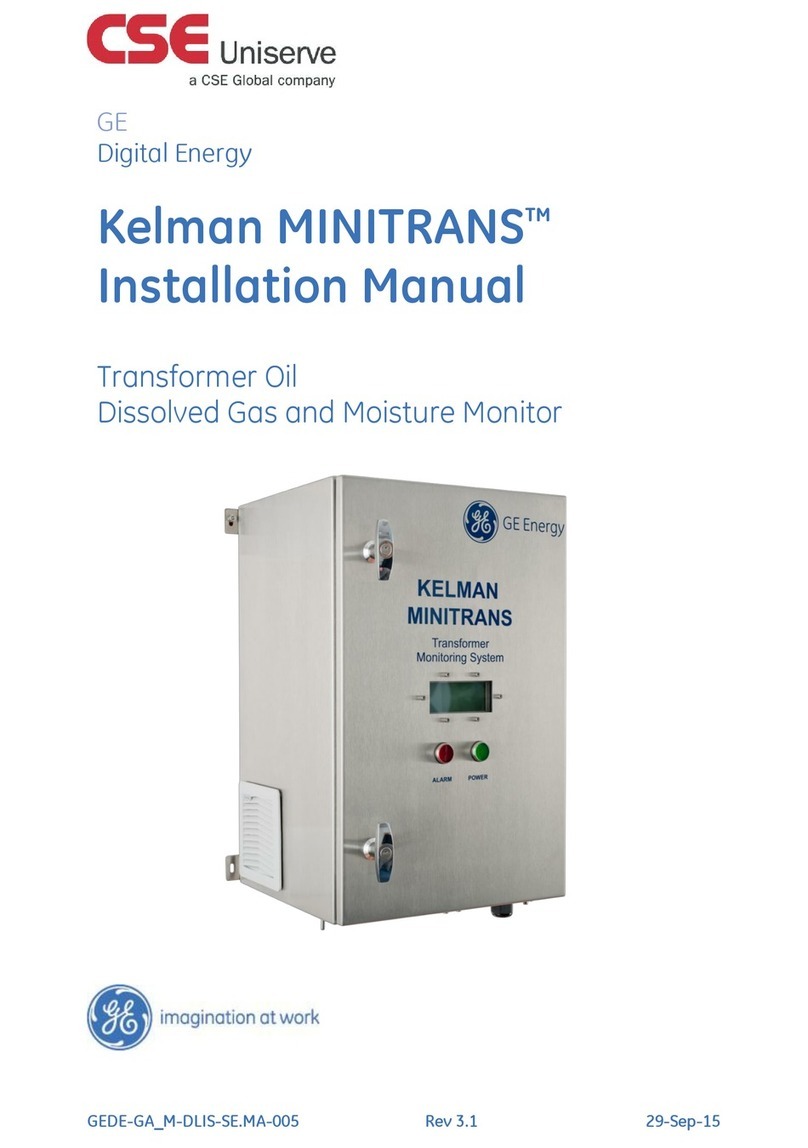
GE Digital Energy
GE Digital Energy Kelman MINITRANS installation manual

ABB
ABB 6553 Series instruction manual
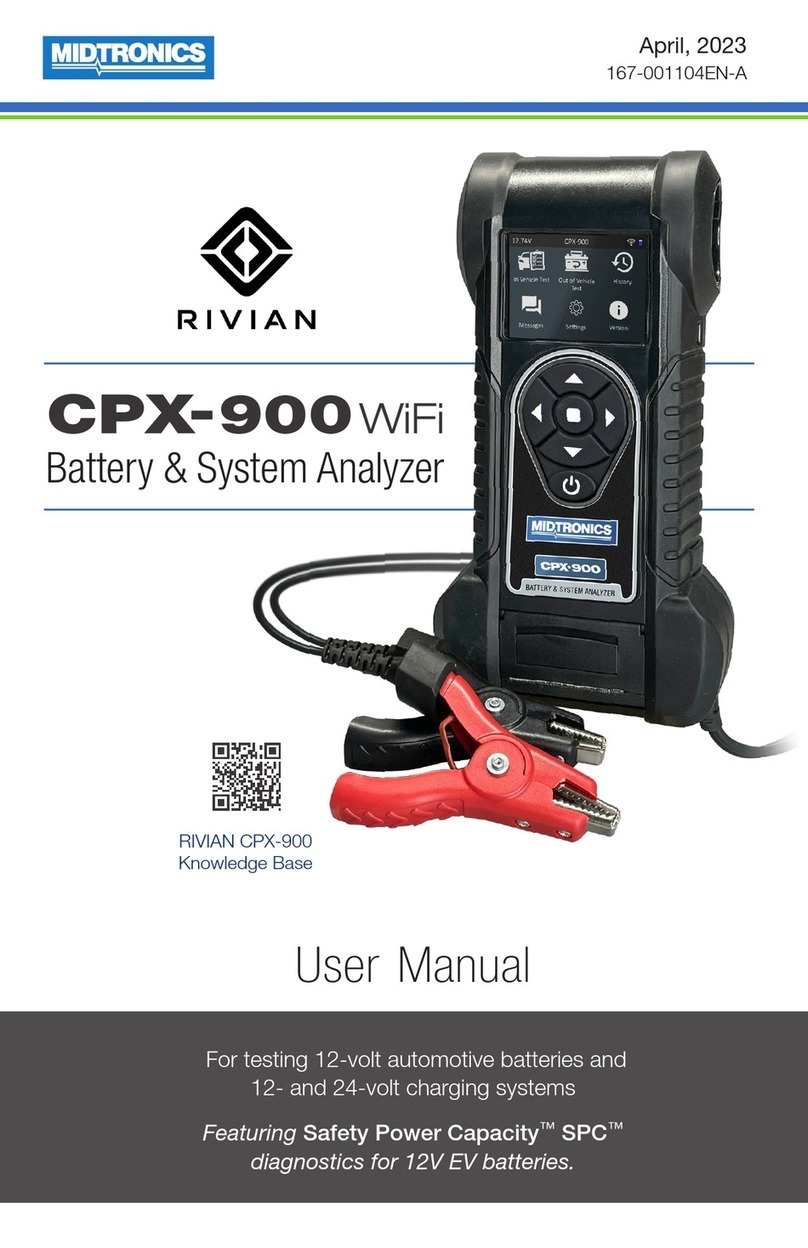
Midtronics
Midtronics RIVIAN CPX-900 user manual
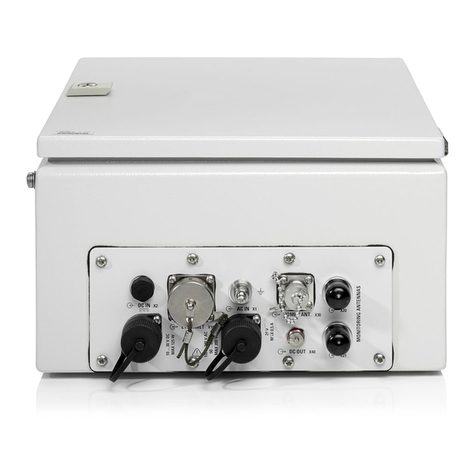
Rohde & Schwarz
Rohde & Schwarz R&S UMS100 manual

SIGLENT
SIGLENT CP6000 Series instructions

Parker
Parker SensoControl Serviceman SCM-150 Series operating instructions
